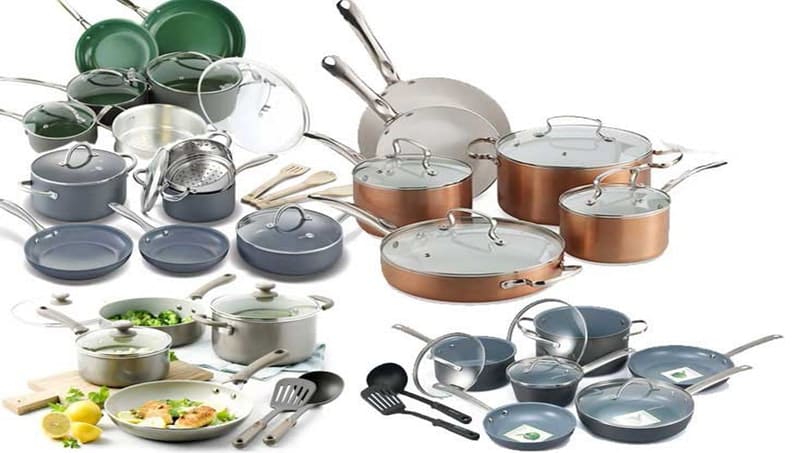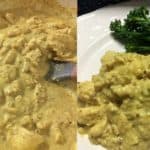I remember when I first started cooking at home, I was not good.
Queue big, important dinner with my in-laws that I was tasked with cooking for despite my suggestions we order-in. Suffice to say, it did not go well. My chicken cooked unevenly, stuck to the pan, and took forever to boot.
We ended up with burnt cutlets two hours later than planned. Some kind soul gave me an out, though. They said it wasn’t my fault, but the fault of my sub-par pans.
Hoping to avoid any more dinner disasters, I did some research and found some new, much better pans that actually did improve my cooking a bit. I thought I’d share what I learned with this handy page: the best five ceramic cookware reviews and buyer’s guide.
Bialetti Aeternum Cookware Set
This ten-piece Italian-made cookware set has an easy-clean white interior and includes a deep sauté pan with a lid. This feature makes it possible for you to shake and toss food. You can use significantly less oil than usual for cooking, too. This set includes a 10¼-inch sauté pan, 8-inch sauté pan, 2- and 2.5-qt pots with lids, 5-qt lidded Dutch oven, and an 11-inch deep sauté pan with a lid.
Pros
- Hi-temp silicone exterior –This nano-ceramic set features a non-stick coating for easy clean-up.
- Soft-touch and heat resistant handles –The make of the handles ensures that carrying the pots is manageable and comfortable, without any heat reaching you.
- Tempered glass lid –These transparent and durable glass lid makes it easy to monitor the food while you are preparing it.
- Covered rivets –The additional covering of rivets that hold the handles helps eliminate the stress of cleaning around rivets.
Cons
- One-color –Unfortunately, this cookware is only available in red.
GreenLife Soft Grip Cookware Set
This 16-piece set was designed with a healthy cooking mindset. It includes a 1- and 2-qt saucepan, 2.5-qt sauté pan, and a 5-qt stockpot, each with a lid. Additionally, there is also a 4-inch mini fryer, four utensils, a 7-inch open frying pan, and a 9.5-inch open frying pan.
Pros
- Variety of colors –If you are someone who wants cookware to match your decor, with this set, you have many choices. You can choose from lavender, burgundy, black, turquoise, and red.
- Stainless steamer –As a bonus, this ceramic cookware set includes a stainless steamer.
- Ergonomic phenolic handles –These soft handles allow you to carry the pot easily. Additionally, they are not attached by rivets, which makes cleaning easy.
Cons
- Non-durable paint –High flames on the stove can easily mark the exterior paint.
T-Fal Initiatives Ceramic Cookware
This 16-piece set is a brainchild of the company that first gave us non-stick pots and pans way back in the 1950s. It includes 7.5- and 11-inch frying pans, each with a lid, a 10-inch square griddle, 1- and 2-qt saucepans with tops, six utensils, and a 5-qt Dutch oven with a lid.
Pros
- Scratch-resistant surfaces –The exterior and interior surfaces of the cookware set are all scratch-resistant and thus retain their smooth finish, even with continued use.
- Glass lids with vents –Again, allowing you to monitor your cooking progress easily.
- Comes with griddle pan and utensils –This includes a 10-inch square griddle that’s great for pancakes and French toast and six durable plastic utensils.
- Heavy-gauge aluminum base– While ceramic, this cookware set features a heavy-gauge aluminum base that makes it easy for even distribution of heat while cooking.
Cons
- Poor durability –Many users complain this set typically begins to fail within a year of use even with handwashing.
WearEver Ceramic Cookware
This 15-piece ceramic cookware set stands out for its non-stick properties. It includes 1-, 2-, and 3-qt saucepans with lids, 8- and 10-inch frying pans, a steamer insert, a 3.5-qt deep sauté pan with a lid, a 5-qt Dutch oven with a lid, and a 12-inch frying pan with a lid.
Pros
- Non-stick architecture –Like most ceramic cookware, this set is non-stick and makes for easy cleaning.
- Comfortable handling –The handles are covered in soft-touch silicone. This feature ensures minimal heat interference when carrying the items.
- Stainless steamer –As part of the set, a stainless steamer is included.
Cons
- Not suited to extreme temperature –High heat tends to leave marks on the exterior of this set. It’s recommended for use with medium heat.
Nuwave Duralon Ceramic Set
This 7-piece set is made by NuWave LLC, which has been making cooking pots and ceramic sets for years. In this set, you get a 2-qt saucepan with a lid, 1.5-qt saucepan with a lid, 10-inch and 12-inch frying pans, as well as a 5.5-qt stockpot with a cover.
Pros
- Nonstick –The interior of this set is coated with Duralon® ceramic non-stick coating that allows for easy cleaning.
- Aluminum-base –These pans are made of a hard-anodized aluminum base that has been reinforced with a steel core for better conduction.
- Vent on lids –In addition to the tempered glass lids, they also come with vents that allow for pressure to be released to reduce the chances of the contents boiling over during cooking.
Cons
- Rivets on handles– The rivets around the handles make cleaning a little bit challenging.
Ceramic Cookware Buying Guide

Now that you have a small sampling of some the best ceramic cookware sets on the market today, let’s take a look at some things to consider while shopping.
How to choose the best ceramic cookware set
When you decide on buying a particular cookware set, or you are shopping around for one, you will see a variety of options. I recommend the following tips to evaluate your options.
Material
When you are going for a ceramic cookware set, it is essential to consider the other materials used in its construction carefully. The most recommended materials are cast iron, aluminum, or stainless steel. These three materials used individually or as a blend ensure even distribution of heat that makes cooking easier. Additionally, they don’t alter the taste or smell of the food in any way.
Budget
You need to determine beforehand what you are willing to spend on a ceramic set. Ceramic sets vary widely in price by manufacturer, set size, and materials used. For example, ceramic-coated cast iron is going to cost far more than aluminum. Set a firm budget and stick to it. You can also try the reverse method—pick a set you like, plan out a budget you can afford each month, and set that much aside until you can buy your dream set.
What’s included in the set?
Finally, evaluate your cooking style and decide which pots, pans, and so on that you’ll actually use as well as which ones are a must-have. For instance, a large family is going to need big skillets and pans, but a single college student likely can get away with smaller items and less of them. Find a set that meets your needs.
What is Ceramic Cookware?
Being the heart of every home, no matter where you are, you want it to be fully equipped with the right cookware sets and decorative pieces. While it is true that choosing the right ceramic cookware for your kitchen can be a daunting and overwhelming experience, here is a simple guide that will help you determine which cooking pans and pots are right for your family.
This article will be talking beyond the design and function, but this will also talk about safety, pots that could contribute to your health, as well as give you a brief overview with regard to these cookware sets’ manufacturing process altogether.
In general, ceramic cookware can be defined differently. You may consider clay pans and pots to be ceramic cookware – the ones that have been baked and finished with a glaze.
Pots made of stainless steel, aluminum, sheet metal, and cast iron (or any other type of metal for that matter), which are all finished with a ceramic enamel coating, can also be considered to be ceramic cookware. Porcelain cookware sets are what most professional chefs prefer these days.
This is because the enamel coating prevents food to stick to the pan, and it is durable enough that it is resistant to chips and scratches. Because of the type of coating that it has, food is also expected to be cooked evenly.
Difference Between Ceramic Cookware Sets And Stainless Steel Sets
The old types of pots and pans such as the copper and cast iron types usually react with acidic foods. The metals from the acidic reaction usually mix with food and produce other elements such as iron.
For people who are iron-deficient, this may not be a bad thing, however, it can cause problems with people who have heightened levels of iron.
Additionally, iron can also mix with food and cause discoloration. When it comes to copper, if it mixes with food, tiny flecks occur. If you’re using carbon steel, it can still cause a chemical reaction with the food. While not considered to be toxic, it may also cause food discoloration at times.
On the other hand, if you’re using stainless steel sets, you’ll notice that food burn easily and sticks to the bottom of the pan. While it is proven to be safe and durable, and with proper use can last for years, it is a poor heat conductor which makes it easier to control the heat when cooking with it.
Clay and ceramic cookware sets, on the other hand, has been proven to be safe and doesn’t have a reaction with foods, even the acidic types.
Toxic metals such as zinc, cadmium ore or lead aren’t found in clay pots and pans and is an environment-friendly and healthy way to prepare foods.
Chemicals Found In Most Ceramic Cookware Pots And Pans
Perfluorooctanoic Acid – Before technological advancements were made in ceramic cookware, lead is the main ingredient used to glaze pans and pots. Recently, it has been found out that some cookware sets now make use of PFOA or Perfluorooctanoic Acid.
Polytetrafluoroethylene (PFOA)
– Teflon®, one of the leading brands in cookware makes use of Polytetrafluoroethylene, which has been around since 1940. Many consumers have stated their concern about the safety of this component.
While this plastic is durable enough, it is also made of waxy and strong plastic material that doesn’t burn – one of the selling points of Teflon®.
Are The Above-Mentioned Chemicals Cancerous?
It has been said that Teflon® isn’t necessarily cancerous. However, it has been found out that PFOA is found in the blood of most Americans at low levels. Research suggests that the chemical PFOA is oftentimes found in every home’s drinking water, dust and even food that is being prepared.
Whether you like it or not, you’ve been exposed to this nasty chemical (unless you’ve been cooking with a cast iron ever since). Teflon®, being the number one cause of the said chemical, which is usually found in every home, expect to have low levels of those chemicals in your blood. If you’re aware of this, whether you’re a cook or a housewife, take no part of it. PFOAs are toxic and shouldn’t be used.
Why Should You Use Ceramic Cookware?
Ever since its discovery, this is considered to be one of the best types of cookware that you can use! Since everyone is now conscious about the food that they prepare, ensuring that your vegetable oil and other ingredients are natural and organic, and don’t want to feed their family with chickens fed with antibiotics and injected with hormones, you should also be concerned about where you would be cooking your food with.
Choosing ceramic cookware has numerous advantages, and one of it being toxin-free and FDA approved. If you’re worried about food sticking to your pans, ceramic cookware sets are non-stick, regardless if you use oil, butter, or none at all.
You don’t have to worry about toxic chemicals and metals that could leach into your food, and you can even cook at high heat without having to worry about your pan burning or crackling.
Another advantage of ceramic cookware is that you get to evenly cook your food, from the inside out, thanks to its far infrared technology.
If you’re worried about the odor, ceramic cookware doesn’t retain odor, which means that bacteria won’t dwell into your pots and pans. Of course, they’re easy to clean and most of them are dishwasher safe – just make sure to check the manufacturer’s manual to verify.
Choosing The Right Ceramic Cookware Sets For Your Needs
1. Material
Not all ceramic pots and pans are created equally. Assess the material and see which one suits your needs. Ceramic cookware provides excellent heat conduction, which means that you don’t have to worry about scorching, scratches, and burning of food.
2. Budget
Of course, it is important to buy cookware that’s well within your budget range. Consider this as an investment so you have to be sure that you’re completely happy with the type that you’ll purchase.
3. What is Your Cooking Style?
Cooks, professional or hobbyists, have their specific cooking style and preference. Choosing a ceramic cookware set that fits their cooking style is an important factor to be taken into consideration.
4. Specific Features, Functionality, and Needs
You would want a ceramic cookware set that is dishwasher safe – so if this is a feature that you’d like, make sure to check if that specific brand is dishwasher safe before making a purchase. What specific type of pot or pan are you in need of? Do you need one for sauteing, stir-frying, or braising? Do you need a large pot or a small pan? Do you prefer your pots and pans to have lids, or are you okay without those?
Understanding what your needs are from a ceramic cookware set plays a crucial set in helping you determine which brand or type works best for you. You would also want to take into consideration the design. Do you want it to have in contrasting colors, or do you prefer it to be in matching colors?
5. Stove Types
While the majority of ceramic pans and pots can be used on the majority of stove types, you’d still want to double-check on this. Are you using an induction cooker? See if the pan you’re eyeing for is induction-cooker friendly. For induction cookers, only the inside of the pan is coated in ceramic enamel. The outer part would still be covered with metals for it to work with your induction cooker.
On the other hand, if you have a gas, ceramic or even electric stovetop, most of these ceramic pots are compatible.
6. Which Specific Type Of Ceramic Cookware Do You Need?
As mentioned earlier, not all types of ceramic cookware are created the same. Some are cheaper as it isn’t 100% glazed with ceramic enamel, while the more expensive ones usually are coated with ceramic as a whole. If you’d ask me, it is highly recommended that you spend a bit more money on the more expensive ones because they’re proven to be durable and would last a long time.
Make sure that you’re buying one that is really coated with ceramic enamel. Real ceramics are smooth and silky in texture.
7. USA Made Ceramic Cookware
In the USA, there are rigid manufacturing standards that are being followed, unlike other countries. To be 100% sure that your ceramic cookware adheres to these standards, buy those brands that are made in the USA. Remember your reason for buying ceramic cookware – you’d want to get rid of lead. Only buy brands that are made with a lead-free glaze.
Take your time to research and learn more about the brand and product prior to making a purchase. You definitely don’t want lead leeching to your food. Only purchase from companies that have a great reputation in this industry, and those that also offer warranties.
8. Temperature Control
The best ceramic pots that you could have in your kitchen are the ones that are made with inorganic and 100% natural ceramic materials. These factors make the cookware durable to extreme heat, but then again, they’re not all created equally. If you would like a ceramic pot or pan that is microwave oven safe, make sure that you check with the manufacturer as the temperature controls aren’t the same with one product to another. Some of the brands are even safe to be used on your oven – so if this is something that you’re specifically looking for, make sure that you check if the brand offers this feature.
9. Size and Color Variations
Ceramic cookware sets that are cadmium free, PFOA, and PTFE-free also come in a variety of sizes, styles, and colors. You may opt to purchase just the individual pieces, or if you want to get the entire set, there are also brands that offer you the entire cooking set for a reasonable price.
For instance, you can get an entire set that comes with a small frypan, a small saucepan, a 2-quart saucepan that comes with a lid and a stewpot that has a lid as well.
For ceramic cookware sets, the lids are usually see-through and are heat resistant making cooking easier.
You would be able to come across some pieces such as a sandwich griddle, or a baking pan made of ceramic. You can choose from a wide variety to mix and match and to add to your collection.
For a 9-in fry pan, they are usually reasonably priced and becomes more expensive if you go for sets or those that come with a tempered glass lid, to those that are already complete sets.
Interesting Facts About Ceramic Cookware
Ceramics are composed of minerals found in clay through processes involving both heating and hardening. Porcelain is also made from clay, although it is done so at higher temperatures than the ones used with ceramics.
Ceramic is not clear, or opaque, whereas, porcelain is transparent, or translucent. Porcelain often feels and looks like it has a more delicate appearance than ceramics do.
Porcelain is also whiter and thinner as compared to ceramics, while also having smooth, fine surfaces.
What is Porcelain Enamel Cookware?
Typically made out of carbon steel or cast iron and then coated with a porcelain enamel, pieces like these aren’t reactive to acids but are very simple to clean. Certain metal pots and pans that are older inevitably turn black in time due to acids.
A product such as this doesn’t require seasoning, like cast iron does. However, it’s just as easily cleaned as ceramic is.
Ceramic Cookware Facts
Pots and pans composed of ceramic bring a lot of versatility to your kitchen, which explains why they’re so frequently available on the Internet. They can withstand a lot of heat but also get stored in your freezer or fridge.
You can even use them in your microwave which metal can’t do. They’re the very least reactive, nor do they need any scrubbing using abrasives in order to clean them.
They start of looking great on your dining table, and if you follow the manufacturer recommendations, they’re going to stay functional and fabulous for quite a long time.
What is Seasoning?
This is what gets cookware ready for using. ‘Seasoning’ just means that you use butter or oil to coat the inside before the first time you use it.
This should always be done for cast iron skillets so they remain non-sticking and smooth. Heat up the pot or pan on a low setting, but only for 30 seconds or so.
Take it off of the heat source before adding a little oil. Then, use a paper towel to rub the oil in.
Wash the pot or pan in some hot soapy water. Then, rinse it off and dry it with a towel.
If your dishwasher is how you clean it, then you’re going to need to actually repeat this whole process on occasion. Dishwashers are pretty tough on ceramic cookware, so it’s better to just handwash them.
How to Deal With Stains?
Use 1-tablespoon bleach inside 8-ounces water. Let it simmer from 10 up to 15 minutes.
Allow it to cool before you use a soft dishcloth or sponge to remove the stain. Wash it off in warm soapy water before rinsing it off and drying it with a towel.
Season it once more with some oil, before repeating the process of washing, rinsing, and drying.
Warping Issues
Pots and pans can warp from many things, including a really hot pan, an empty pan that gets overheated, or if they’re put either into cold water coming out of a faucet or immersed into standing cold water. Never do either of the cold water actions.
You need to always let your ceramics cool at a natural pace while sitting in room-temperature air. Also, never put a hot pan onto a cold surface.
Things To Avoid
Never confuse Teflon for ceramic, as they are very different materials. We never recommend Teflon or review it considering its potential for danger.
Avoid anything with cadmium or lead in them. US federal-level regulations ban the use of these in anything that might come into contact with food.
Misusing your pots and pans can wind up voiding the warranty from the manufacturer. Over time and with enough use, you might wind up with some discolorations and other marks, but they’re not likely to change the actual performance of any impacted cookware.
Don’t use metal utensils when working with non-stick surfaces. Instead, choose utensils or tongs that are wood, ceramic, bamboo, acrylic, plastic, or rubberized.
We don’t suggest Pam cooking spray to use for an oil, since it’s gummy, sticky, and hard to get rid of. If you want to have a great time cooking with your ceramics, then choose oils or butter.
Never leave your empty sandwich griddle, pot, or pan on a burner that’s still hot.
If you have a halogen stove top, don’t let the bottom of any pot go past the heating element’s diameter.
Never cut any food while it’s still in the pan.
Don’t use beaters or mixers in any of your cookware.
Let your pots and pans have time to cool down while sitting at room temperature prior to cleaning them after you use them. When you do clean them, don’t use brushes, nylon scrubbing pads, or anything with steel wool.
Usage Tips For Ceramic Cookware
Try to avoid using sharp forks or edges of any kind when using this cookware. If you buy cookware that says it’s okay to use metal utensils with, you’re probably going to be fine though.
Having said that, don’t use sharp utensils or knives to cut things up while inside the cookware. It’s typically not a good idea to use rotary beaters or electric hand mixers inside the cookware.
Don’t put any product in the oven if it has wood handles or wooden knobs on the lid. Wood in the oven burns and is going to turn black.
Avoid wood products in your dishwasher too. Any colored or black handles made up from phenolic, which is a mix of plastic and resin, over steel, as well as rubber-gripper handles are up oven-safe for 350F or less.
Preheat your oven up to 350F prior to putting your cookware in. Ovens which preheat have higher temperatures so you hit your needed baking temperature faster.
As long as you use common sense, any tempered glass shouldn’t break. Big impacts might cause chipping.
Never place a glass lid right over the heating element of a stove. Don’t weaken any tempered glass by using sharp knives or cleaning pads.
Keep your cookware away from any sudden changes in temperature. Let things cool down to room temperature first, as you should never place a hot piece into your fridge or freezer.
Frequently Asked Questions About Ceramic Cookware
Q: What is used to make ceramic cookware?
A: Ceramic cookware is composed of a kiln-baked ceramic that has a ceramic glaze covering.
Q) Is aluminum a cause or risk for Alzheimer’s disease?
A: Absolutely not, as the Food and Drug Administration concluded long ago that there is no connection. Also, aluminum has been safely used for many years in cookware all around the world, and even in those cases, the aluminum itself is covered with ceramic, nor are you eating out of the pan.
Q: Are ceramic coverings brittle or weak?
A: When most consumers come across the word ‘ceramic’, they start thinking about pottery, but in the case of ceramic cookware, the better analogy is common bricks, which are another kind of kiln-fired ceramic. Ceramic cookware is robust, reliable, and something that lasts for years when properly cared for.
Q: How can I restore an aluminum pan bottom that has gotten discolored?
A: Aluminum metal is one of the planet’s natural metals, and one that reacts with acidic foods like tomatoes; given that, you need to avoid food spills happening over the sides. Don’t use your dishwasher or strong detergents for cleaning in order to avoid weird colors, and instead clean pan or pot bottoms by hand using Brillo or steel wool pads, but only on the actual aluminum areas, not the ceramic parts.
Q: Can ceramic break?
A: Anything can break under the right circumstances. However, ceramic that is handled right is very strong and should stand the test of time even better than glass cookware.
Q: Do I need to season my ceramic cookware like I do with cast iron?
A: This isn’t necessary as long as you wash all your cookware when you first get it. When you do start to cook, add cooking oil, margarine, or butter in order to totally cover the bottom. Once the butter melts, put your food in.
Avoid cooking sprays like Pam. They’re not actually pure, and they also leave behind a sticky residue that takes forever to wash off.
Q: What is ceramic glaze composed of?
A: Ceramic glazing is resistant to bacteria and shouldn’t stain from even the most acidic foods, like tomatoes. It’s made to be totally non-reactive in order to avoid hurting the finish.
Q: How can I best care for my cookware?
A: Don’t put things in your dishwasher because of the harsh detergents involved. Hand-washing is the best way to go, and quite easy to boot.
Soak your pot or pan in hot water with dish detergent. Then, wash it, rinse it, and dry it with a towel.
If you want it to last you for many years, then avoid scouring powder, steel wool pads, anything that has a rough sponge on one side, or any scraper made from anything other than plastic, silicone, or nylon.
Avoid nesting your cookware. Use paper towels or even bubble wrap in between every piece.
Q: How good is ceramic cookware for the planet and the environment?
A: Ceramic cookware is good for us and good for the climate too. Since it’s only partially aluminum, it’s not reactive to many foods or toxic, meaning there aren’t fumes or gas odors to worry about or endanger birds.
Q: What temperature ranges are best for cooking with ceramics?
A: The best range is low heat up to medium heat. When a pot gets too hot, the ceramic might discolor or burn, and it might also lose its non-stick properties.
Q: Are ceramic cookware pieces usable for cooking in both convection ovens and also the various stove top surfaces?
A: Absolutely not! Some brands aren’t usable for induction stove tops, but might be safe on glass, gas, halogen, and electric models. Read up on the brand you prefer to find out what kind of stove tops you can use it on safely.
Convection ovens are really just smaller versions of bigger ovens. Only use ceramic cookware in the ovens that their manufacturer lists as safe.
Metal content for the base and handles means that microwave use if out of the question.
Q: What oven temperatures are safe for using my cookware?
A: Every brand has its own temperature ratings. Check out brand reviews and the instruction manual first.
Q: Are there any metals in ceramic cookware?
A: Modern ceramic cookware has an aluminum base underneath the ceramic finish. Ceramics don’t have ‘dangerous’ metals like cadmium or lead, but some have copper, which is fine.
Conclusion
Good ceramic cookware is an affordable and effective way to cook. Use our 5 suggestions to improve the function and aesthetic appeal of your kitchen at the same time.
Keep reading reviews to learn what others have to say, and always feel free to contact us with any ideas, comments, or questions. We cherish feedback and answer as much as we can.
Ceramic cookware revolutionized cooking for me. The clean-up is easier. The food sticks less and cooks more evenly, and best of all, no worrying about Teflon flakes in my food if I use the wrong stirring spoon.
I hope my review helps you find a cookware set that makes preparing meals a bit easier too. If I had to recommend just one to take a hard look at, it would be the GreenLife Soft Grip Cookware Set. This 16-piece set offers you flexibility. You also can choose from a variety of colors—though those colors do get take on a little rugged look over time.











